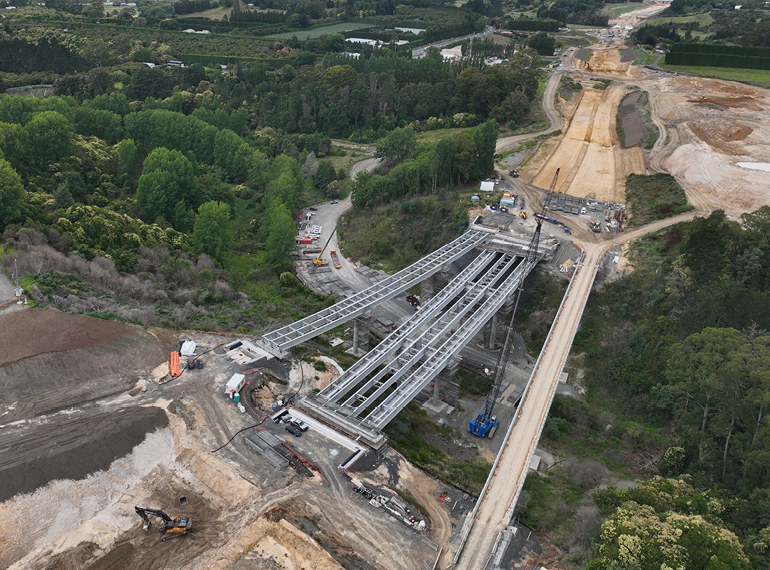Infrastructure for growth
Well-planned infrastructure supports the efficient and sustainable movement of people, goods, and information, and facilitates trade and investment while also improving living standards. It is an essential ingredient to enable and drive economic growth. According to the International Monetary Fund, closing New Zealand’s infrastructure gap could increase real GDP by as much as 0.8 per cent in the long term.
On this page
New Zealand’s infrastructure deficit is limiting productivity and higher living standards
New Zealand faces several challenges in delivering world-class infrastructure. It has become too difficult to build in New Zealand, limiting the country's ability to meet its growing needs. Complex and inefficient resource management and regulatory processes have slowed down project approvals and delivery, creating uncertainty for investors and delaying much- needed developments. These barriers contribute to New Zealand’s long-standing housing affordability challenges, increasing the price of land and making it more difficult to build homes.
The affordability of large-scale infrastructure projects remains a key issue, necessitating innovative funding and financing solutions. Additionally, as cities expand, balancing urban growth with environmental sustainability and resilience presents an ongoing challenge that requires integrated planning and investment.
It is critically important to manage New Zealand’s new infrastructure needs to capture the opportunities that a comparative advantage in cheap, renewable energy affords to the country. Investment in infrastructure will enable New Zealand to attract modern manufacturing and support the use of innovative technologies such as the powering of data centres for AI.
The Government will enable more quality infrastructure by reducing the roadblocks to delivery
There are significant opportunities to improve the pace of infrastructure delivery in New Zealand, the quality of that infrastructure, how it is financed, and how it is managed over its lifetime. The Government is making major changes to the infrastructure planning and delivery system to facilitate this change.
The Government has initiated an overhaul of the outdated Resource Management Act (RMA). In December, a second Amendment Bill was introduced to Parliament to make critical short-term improvements to the RMA ahead of phase three of reforms. The final phase will begin shortly and include fundamentally replacing the RMA with a system based on the enjoyment of property rights, that makes it easier, faster and cheaper to build while still protecting the natural environment.
Replacement for the Resource Management Act takes shape(external link) — Beehive.govt.nz
The Government has also passed the Fast-track Approvals Act, with 149 projects with significant regional and national benefits to be referred for expedited consenting. This includes projects that partner with Iwi/ Hapū and there is an opportunity for further co-investment opportunities.
One-stop shop fast-track bill passes third reading(external link) — Beehive.govt.nz
The Fast-track Approvals Act is key to unlocking opportunities for New Zealand, faster. Progressing these changes will improve the speed and process for resource approvals which could enable:
- 55,000 new homes will help to address New Zealand’s housing crisis.
- 180 kilometres of new road, rail and public transport routes to support growth and get people and freight where they need to go, quickly.
- 3,000 megawatts of new renewable electricity to boost energy security and help New Zealand address its climate change goals.
- 143,000 tonnes of aquaculture to strengthen partnerships with iwi and boost Māori development.
- 11 new mining projects to contribute to the Government’s objective of doubling the value of our mineral exports to $3 billion, delivering benefits to the regions and national GDP.
The Government has made changes across the infrastructure system to clarify the roles of key agencies. This included establishing National Infrastructure Funding and Financing Limited (NIFFCo) in December last year to enhance the Crown’s private finance capability. NIFFCo provides expertise in public-private partnerships and capital markets, supporting agencies with large-scale projects, evaluating market-led proposals, and connecting international investors to New Zealand's infrastructure pipeline.
New infrastructure agency up and running(external link) — Beehive.govt.nz
By December, the Infrastructure Commission will deliver the 30-year National Infrastructure Plan. This will give the Government a long-term view of planned investment over the next 10 years,
New Zealand’s infrastructure needs, and the spending required over the next 30 years to address them.
First steps towards National Infrastructure Plan(external link) — Beehive.govt.nz
Fast-track Approvals
The Government has put in place a new one-stop-shop Fast-track Approvals scheme that will make it quicker and easier to build the infrastructure projects New Zealand needs to grow its economy. It cuts through the red tape and long approvals processes that slow down infrastructure development.
The Fast-track Approvals Act lists 149 projects with significant regional or national benefits, from housing to energy, transport, mining and the primary sector that will be able to apply for approval in this new framework straight away.
This new scheme is now open for other projects with significant regional or national benefits to apply for approval. More information, and how to apply:
The Government has launched the $1.2 billion Regional Infrastructure Fund to invest in infrastructure to enable economic growth in New Zealand’s regions, with projects under consideration for investment across the country.
Regional Infrastructure Fund(external link) — Kānoa Regional Economic Development & Investment Unit
The Government is also establishing Regional Deals to unlock the funding and financing tools, reduce regulatory barriers, and enable strong collaboration between central and local government to deliver a pipeline of infrastructure that delivers for New Zealanders. This includes critical upgrades to housing, roads and other infrastructure to enable economic growth.
Government moving forward with Regional Deals(external link) — Beehive.govt.nz
The Government will continue to invest heavily in infrastructure in its budgets, including a record investment in Budget 2024 across a range of sectors (see Figure 4).
Figure 4: Net purchases of physical assets by the Crown, Crown entities and KiwiRail

Source: Budget 2024
Text description of graphic
The Government has significant reforms underway in key infrastructure sectors
The Government Policy Statement on Land Transport set the National Land Transport Fund at $22 billion over the next three years, and referenced new categories of transport projects such as the Roads of National Significance programme which includes 17 new state-of-the-art roads across the country.
Roads of National Significance moving at pace(external link) — Beehive.govt.nz
The Going for Housing Growth Programme will help tackle New Zealand’s long-standing housing shortage, improving housing affordability by significantly increasing the supply of developable land for housing, both inside and at the edge of urban areas. To reduce building and construction costs, barriers are being removed to overseas building products. Other moves to reduce red tape and enable houses to be built faster include expanding self-certification for trades, increasing the use of remote building inspections, and reforming building consent authorities.
Going for Housing Growth stage one unveiled(external link) — Beehive.govt.nz
Reform of the Public Works Act is underway to make it easier for the Crown to deliver infrastructure projects that provide wide public benefit, such as water services, schools, roads and disaster resilience. The Act has not been significantly amended for more than 30 years and is no longer fit for purpose. Amendments to enable infrastructure to be built and support economic growth will be introduced to Parliament in the middle of 2025.
Expert panel appointed to review Public Works Act(external link) — Beehive.govt.nz
The Government has committed to reforming water services to lift investment in this critical infrastructure and downward pressure on water-related costs, including rates and charges, through its Local Water Done Well Programme.
Local Water Done Well bill passes(external link) — Beehive.govt.nz
Clean, reliable and affordable energy provision is vital for economic activity. The Government will enact legislation in July enabling offshore renewable energy generation and will make changes to the planning system to enable implementation of the Electrify New Zealand programme.
Offshore Renewable Energy Bill passes first reading(external link) — Beehive.govt.nz
Next steps on Electrifying New Zealand(external link) — Beehive.govt.nz
The Crown’s balance sheet is vast and includes a range of physical assets that are fundamental to the delivery of core government services, ranging from schools and hospitals to prisons. Beyond simply investing more, the Government is considering how public asset management and performance can be improved. This means the Crown owning the right assets and that they are being managed in the right way to deliver the right services for New Zealanders. To ensure the Crown’s capital is well allocated and used and managed efficiently and effectively, requires the skills and experience of both the public and private sectors.
Finally, the Government is responding to the Independent Inquiry into the School Property System, which concluded that the way school property is delivered is not fit for purpose. The Government has made interim improvements to address the Inquiry’s recommendations and is taking steps to establish a more efficient and sustainable solution for how school property is delivered.
Response to Ministerial Inquiry into School Property(external link) — Beehive.govt.nz
Roads of National Significance
The Roads of National Significance programme will see 17 new state-of-the-art roads developed across the country.
Investments in these essential corridors will make it easier for New Zealanders to get where they need to go, create a more productive and resilient transport network, drive economic growth, and unlock land for thousands of new houses.
A report focusing on two proposed Roads of National Significance, Warkworth to Wellsford and Cambridge to Piarere, found that, once operational, each of these projects could contribute up to $500 million a year to New Zealand’s GDP.
Work has also kicked off on the Hawke’s Bay Expressway and the Government is planning for six to seven projects to commence construction within the next three years.

Te Rangi tua nehe/Minden Gully area of the Takitimu North Link Stage 1 site, at Te Puna. Takitimu North Link will provide an efficient, reliable and safer route between Tauranga and Ōmokoroa.
Government's actions
Delivered
- Announced reforms to the innovation, technology and science system to clarify priorities, lift economic outcomes and harness advanced technology for a more prosperous future
Reforms to boost science sector and economy(external link) — beehive.govt.nz
- Introduced legislation to remove the gene technology ban and enable the safe use of gene technology in agriculture, health science and other sectors
Gene Technology Bill passes first reading(external link) — beehive.govt.nz
- Launched the Space and Advanced Aviation Strategy 2030 with a target of doubling the value of the sector by 2030
New Zealand Space and Advanced Aviation Strategy 2024-2030 [PDF, 2.2 MB]
- Created the first Prime Minister’s Space Prize, to inspire the next generation of space professionals
PM’s Space Prizes highlight talent and innovation(external link) — beehive.govt.nz
- Launched a framework to accelerate the responsible use of Artificial Intelligence technologies across the New Zealand Public Service
Public Service AI Framework(external link) — digital.govt.nz
Underway
- Establishing new Public Research Organisations, focused on the bio-economy, earth sciences, health and forensic sciences, and advanced technologies
Reforms to boost science sector and economy(external link) — beehive.govt.nz
- Establishing the Prime Minister’s Science, Innovation and Technology Advisory Council to enable prioritisation and focus across the science, innovation and technology system
Reforms to boost science sector and economy(external link) — beehive.govt.nz
- Passing a new Gene Technology Bill to end the near 30-year ban on gene technology outside the lab, and to establish a regulator to enable the safe use of gene technology and regulated organisms
Gene Technology Bill passes first reading(external link) — beehive.govt.nz
- Encouraging the growth of the space and advanced aviation sector by removing unnecessary red tape and freeing up innovators to test and commercialise their technology and ideas
Government helping advanced aviation take off(external link) — beehive.govt.nz
- Developing a National AI Strategy, highlighting the opportunities it offers for economic growth in both the public sector and wider economy
- Engaging with business on how to lift their investment in R&D and capital intensity, to accelerate uptake of automation, AI, data analytics and better technology

